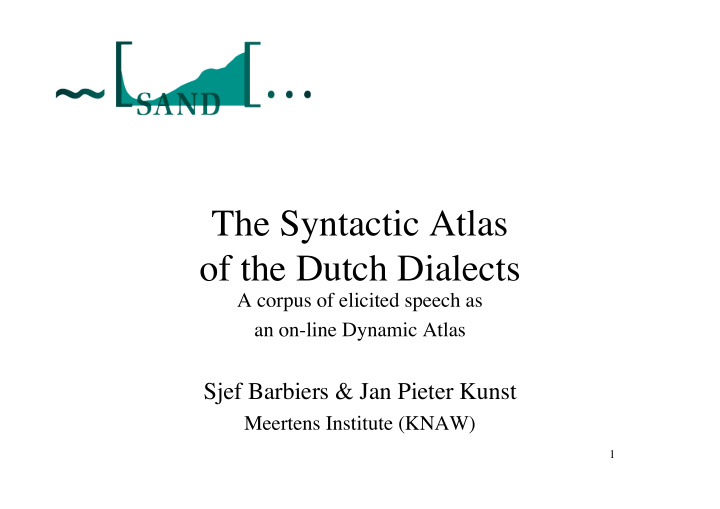



The Syntactic Atlas of the Dutch Dialects A corpus of elicited speech as an on-line Dynamic Atlas Sjef Barbiers & Jan Pieter Kunst Meertens Institute (KNAW) 1
Coordination • Hans Bennis (Meertens Institute) • Hans den Besten (University of Amsterdam) • Magda Devos (University Ghent) • Johan Rooryck (Leiden University) • Johan Van der Auwera (University Antwerpen) 2
Project leader Sjef Barbiers (Meertens Institute) Research Jeroen van Craenenbroeck (Leiden University) Marjo van Koppen (Leiden University / Meertens Institute) Annemie Neuckermans (University Antwerpen) Guido Vanden Wyngaerd (University Antwerpen) Gunther de Vogelaer (University Gent) Henk Wolf (Fryske Akademy) Hedde Zeijlstra (University of Amsterdam) Methodology Leonie Cornips (Meertens Institute) 3 Willy Jongenburger (Meertens Institute)
General assistance Margreet van der Ham (Meertens Institute; daily coordination) Irene Haslinger (Meertens Institute) Vicky van den Heede (University Gent) Mathilde Jansen (Meertens Institute) Alies MacLean (Meertens Institute) Vivien Waszink (Meertens Institute) Sofware development Jan Pieter Kunst (Meertens Institute) Ilse van Gemert (Meertens Institute) 4
Financial support • VNC (Flemish-Dutch committee for Dutch Language and Culture) • KNAW (Royal Dutch Academy of Arts and Sciences) • NWO (Dutch Science Foundation) • FWO (Flemish Science Foundation) • Meertens Institute (KNAW) • Universities of Amsterdam, Antwerpen, Ghent & Leiden 5
Theoretical perspective • generative syntax • language typology Empirical perspective • dialect geography: Dutch speaking area in the Netherlands and Belgium 6
Empirical domains • left-periphery of the clause e.g., complementizer agreement, subject doubling, relative clauses, Wh-clauses • right-periphery of the clause e.g., verbal clusters, verb cluster interruption, IPP • negation and quantification e.g., negative particle, negative concord, scope, negative quantifiers • pronominal reference e.g., reflexives, reciprocals, weak and strong pronouns 7
Data • Postal interviews (2000; pilot): 368 informants in 318 locations; 424 test sentences • Oral interviews (2001/2): 607 informants in 267 locations (110 in Belgium + French Flanders; 157 in the Netherlands); > 160 test sentences) • Telephone interviews (2003): 252 locations, average of 105 test sentences 8
Informants (i) All subjects were native speakers of the local dialect; (ii) Both the subject and their parents were born in the same community and have lived there until adulthood; (iii) The subjects didn't leave their community for longer than seven years; (iv) The subjects speak their local dialect in several functional domains; (v) The subjects belong to lower middle class; (vi) The subjects were aged between 55 and 70 years 9
Methodology ( oral fieldwork) Interviews in dialect between two native speakers of the local dialect (one speaker is assistant-interviewer who questions the other) to avoid accommodation, i.e., adjustment from the dialect in the direction of the standard-like varieties. 10
Results (1) Barbiers, S., H. Bennis, G. De Vogelaer, M. Devos and M. van der Ham (2005). Syntactic Atlas of the Dutch Dialects , Volume 1. Amsterdam University Press. 11
Results (2) Dissertations • Craenenbroeck, Jeroen van (2004). Ellipsis in Dutch Dialects. LOT Dissertation 96. • Zeijlstra, Hedde (2004). Sentential Negation and Negative Concord. LOT Dissertation 101. • Koppen, Marjo van (2005). One Probe - Two Goals: Aspects of agreement in Dutch dialects. LOT Dissertation 105. • De Vogelaer, Gunther (t.a.). Subjectsmarkering in de Nederlandse en Friese dialecten. Diss. Gent. • Neuckermans, Annemie (t.a.). Negatie in de Vlaamse dialecten. Diss. Gent. • Wolf, Henk (in prep.). The Imperative in Frisian 12
Results (3) Dynamic Atlas (on-line) – database (transcriptions, speech) – search engine – cartographic software 13
Current size of the SAND-corpus • Postal interviews 156,000 question - answer pairs (424 test sentences * 368 informants) • Oral interviews - Transcription of 45,000 question-answer pairs (1,200,000 words; 267 dialects of Dutch) - Partial tagging - 425 hours of speech • Telephone interviews 26,000 questions answer-pairs 14 (105 test sentences * 252 different locations)
Dynamic Syntactic Atlas of the Dutch Dialects http://www.meertens.nl/sand/; on-line in May 2005 15
Recommend
More recommend